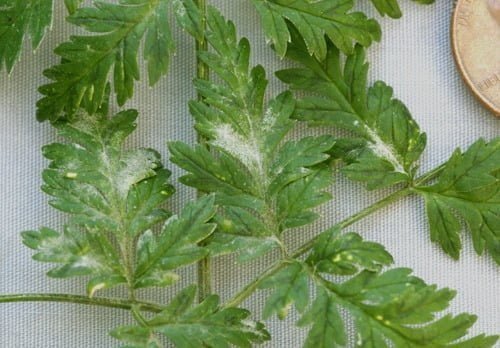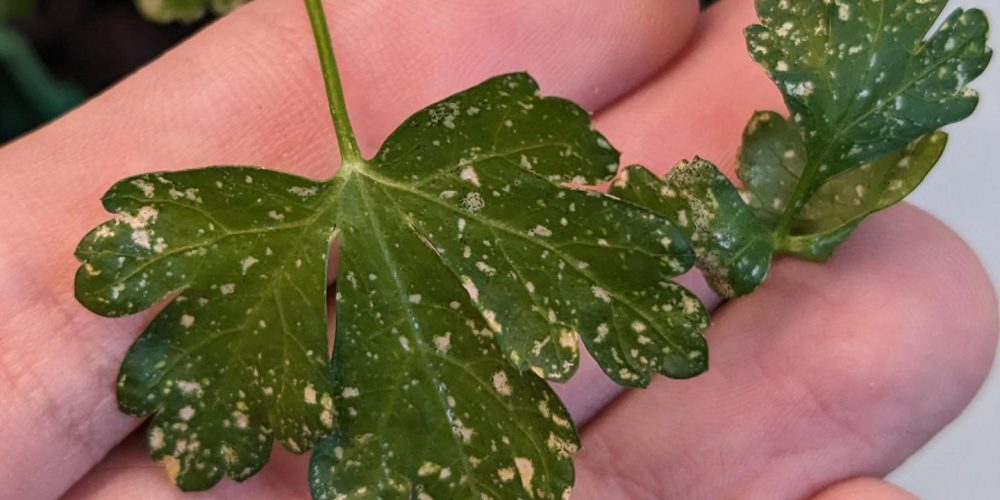Table of contents of the article
TogglePowdery mildew in parsley is a fungal disease that affects plant health and reduces the quality of the crop. In this article on your website, WORLD OF PLANTS, we will review how to identify this disease and ways to prevent it in order to preserve the freshness and productivity of parsley.
Symptoms and damages of powdery mildew in parsley
Powdery mildew
The causative agent is the fungus: Sleveillula taurica
Symptoms appear in the form of white powdery spots on the leaves, buds and flowers, then the leaves turn yellow and twist, eventually leading to their fall.
Prevention and treatment of powdery mildew in parsley
- Choose disease-free seeds or purchase healthy seedlings.
- Proper health care and good air circulation (using adequate spacing when planting to avoid crowding) will help maintain good plant health because diseases affect stressed plants.
- Remove the remains of previous plants and burn them.
- For chemical resistance, we follow the following:
- Use one of the following pesticides (Cumulus - Amstar - or other sulfur compounds).
- For treatment, use (Amstar or Belize).
Causes of powdery mildew in parsley
The infection occurs due to high temperature and humidity around the plant, as warm temperatures between 21-27 degrees Celsius are suitable for fungal growth to begin on the plant.
Possible damage to the plant due to powdery mildew in parsley
Powdery mildew fungi clog the pores of the leaves and block light from the cells, which impairs the plant's ability to carry out photosynthesis. Plant growth stops, leaves fall, and the plant struggles to survive.
Controlling powdery mildew in parsley
- Choose a planting location for plants in a sunny place according to their needs to avoid high humidity.
- Planting resistant varieties saves a lot of trouble later, or planting fast-growing varieties of summer squash to avoid this disease.
- Plant plants at relatively far apart distances so that each leaf is well exposed to the sun and fresh air and avoids high temperature and humidity.
- Disinfect shears and tools used in the field after using them on infected plants.
- If an infection occurs and spreads, remove the leaves that show symptoms of infection, or remove the plant if it is completely infected and dispose of it by burning away from agricultural land.
- Use organic fungicides that contain sulfur as the active ingredient.

Powdery mildew spread
E. heraclei is thought to be seed-borne. Hot, dry conditions promote the disease while humid weather and overhead irrigation retard it. Disease progression can be rapid during late summer and early fall. Spores produced on leaf surfaces spread rapidly within the crop by air currents. The fungus likely persists season after season on volunteer plants and sequential host crops and perhaps via “survival” spores in crop debris.
Control of powdery mildew
- Maintain good hygiene practices, such as weed control, avoid successive plantings and transport of crop residues.
- Avoid shaded conditions because sunlight harms the survival of germs.
- Use overhead irrigation.
In conclusion, we would like to note that we, at the world of plants website, offer you all the necessary services in the world of plants, we provide all farmers and those interested in plants with three main services::-
- Artificial intelligence consulting service to help you identify diseases that affect plants and how to deal with them.
- Blog about plants, plant diseases and care of various crops ... You are currently browsing one of her articles right now.
- An application that provides agricultural consultations to clients, as well as a service for imaging diseases and knowing their treatment for free – Click to download the Android version from Google Play Store، Click to download the IOS version from the Apple App Store.
References




